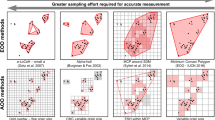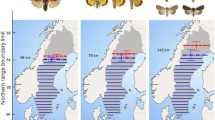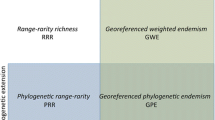Abstract
Many different measures of range size are used for both empirical and conservation purposes. The possible consequences of the particular methods used in determining observed patterns of results are seldom considered. Using species of butterflies and freshwater molluses in Britain, we investigate the relationship between the range sizes measured by nine different methods and the sets of rare species they distinguish. A comparison of range sizes measured at different scales. Britain and Europe, is also made for the butterflies. We find that for many studies involving range size the various measures of range size are interchangeable. With respect to the identification of rare species the results are not as clear.
Similar content being viewed by others
References
Anderson S (1984) Geographic ranges of North American birds. Am Mus Nov 2785: 1–17
Brown JH (1984) On the relationship between abundance and distribution of species. Am Nat 124: 255–279
Gaston K J (1990) Patterns in the geographical ranges of species. Biol Rev 65: 105–129
Gaston KJ (1991) How large is a species' geographic range? Oikos 61: 434–438
Gaston KJ (1994a) Rarity Chapman and Hall, London
Gaston KJ (1994b) Measuring geographic range sizes. Ecography 17: 198–205
Gaston KJ, Lawton JH (1990) Effects of scale and habitat on the relationship between regional distribution and local abundance. Oikos 58: 329–335
Harding PT, Sheail J (1992) The Biological Records Centre: a pioneer in data gathering and retrieval. In: PT Harding (ed) Biological recording of changes in British wildlife. HMSO, London, pp 5–19
Hengeveld R (1990) Dynamic biogeography. Cambridge University Press, Cambridge
Hengeveld R, Haeck J (1981) The distribution of abundance II. Models and implications. Proc K Ned Akad Wet C84: 257–284
Hengeveld R, Haeck J (1982) The distribution of abundance. I. Measurements. J Biogeogr 9: 303–316
Higgins LG, Riley ND (1983) A field guide to the butterflies of Britain and Europe, 5th edn. Collins, London
H M Government (1994) Biodiversity: the UK action plan. HMSO, London
ICBP (1992) Putting biodiversity on the map: priority areas for global conservation. International Council for Bird Preservation, Cambridge
Jaccard P (1912) The distribution of the flora in the alpine zone. New Phytol 11: 37–50
Lawton JH (1994) Population dynamic principles. Philos Trans R Soc Lond B 343: 61–68
Mace GM (1994) Classifying threatened species: means and ends. Philos Trans R Soc Lond B 343: 91–97
Perring FH, Farrell L (1983) British Red Data Books. 1. Vascular plants. Royal Society for Nature Conservation, Nettleham
Pollard E (1991) Changes in the flight pattern of the hedge brown butterfly Pyronia tithonus during range expansion. J Anim Ecol 60: 737–748
Rapoport EH (1982) Areography: geographical strategies of species. Pergamon, Oxford.
Schoener TW (1987) The geographical distribution of rarity. Oecologia 74: 161–117
Taylor JW (1907) Monograph of the land and freshwater Mollusca of the British Isles. Taylor Bros, Leeds
Thomas CD, Mallorie HC (1985) Rarity, species richness and conservation: butterflies of the Atlas Mountains in Morocco. Biol Conserv 33: 95–117
Thomas JA (1991) Rare species conservation: case studies of European butterflies. In Spellerberg IF, Goldsmith FB, Morris MG (eds) The scientific management of temperate communities for conservation. 31st. Symposium of the British Ecological Society. Blackwell, Oxford, pp 149–198
Virkkala R (1993) Ranges of northern forest passerines: a fractal analysis. Oikos 67: 218–226
Williams PH (1992) WORLDMAP priority areas for biodiversity. Using version 3. Privately distributed, London
Williamson MH, Lawton JH (1991) Fractal geometry of ecological habitats. In: Bell SS, McCoy ED, Mushinsky HR (eds) Habitat structure: the physical arrangement of objects in space. Chapman and Hall, London, pp 69–86
Author information
Authors and Affiliations
Rights and permissions
About this article
Cite this article
Quinn, R.M., Gaston, K.J. & Arnold, H.R. Relative measures of geographic range size: empirical comparisons. Oecologia 107, 179–188 (1996). https://doi.org/10.1007/BF00327901
Received:
Accepted:
Issue Date:
DOI: https://doi.org/10.1007/BF00327901




